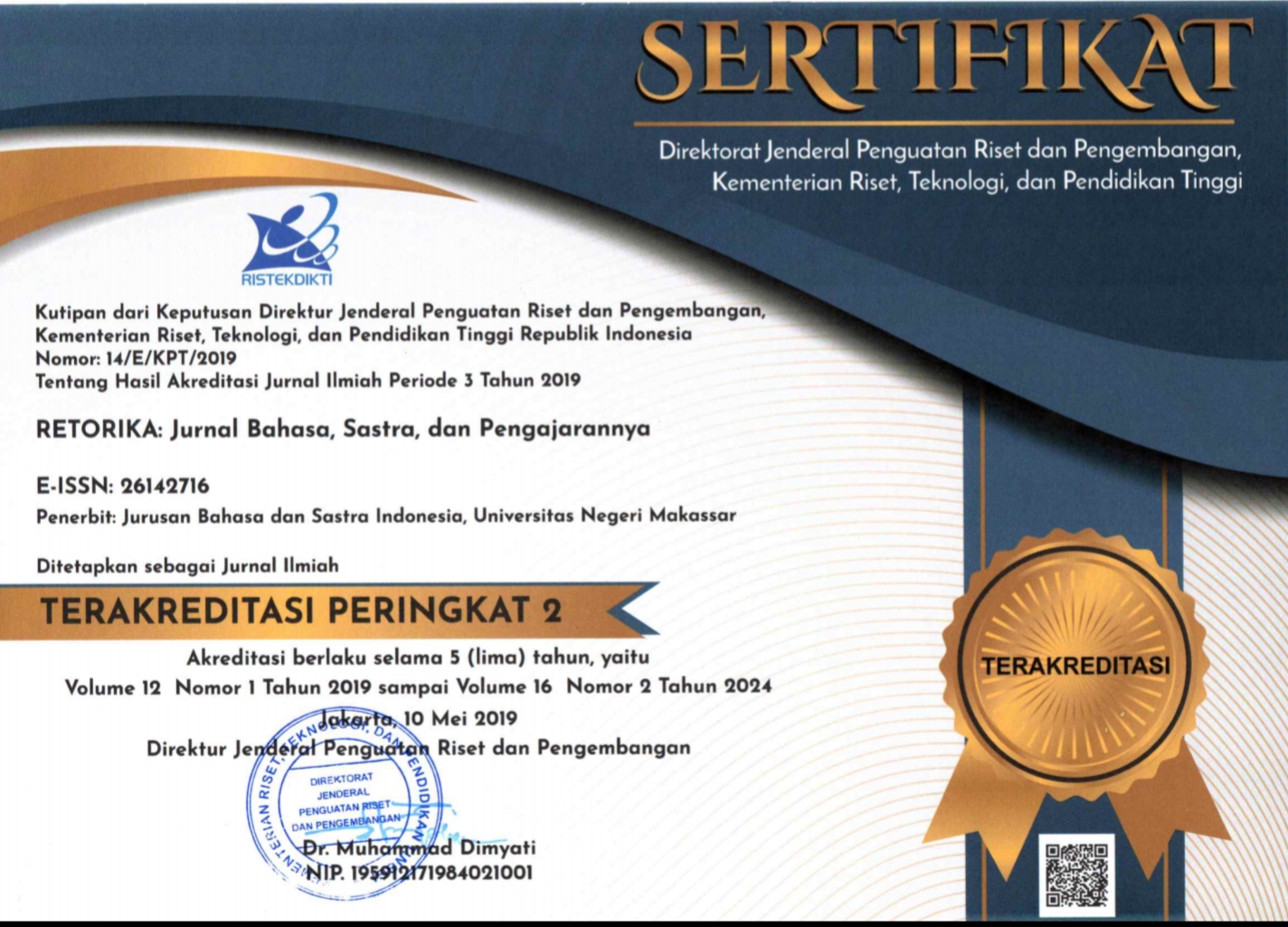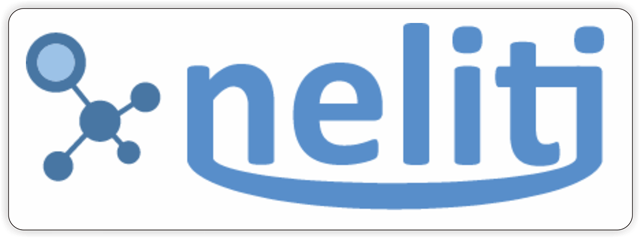REVITALIZATION OF JAVANESE IN SCHOOL ENVIRONMENT IN ERA 4.0: LINGUISTICS LANDSCAPE PERSPECTIVE
(1) Balai Bahasa Provinsi Daerah Istimewa Yogyakarta
(2) Balai Bahasa Provinsi Daerah Istimewa Yogyakarta
(3) Balai Bahasa Provinsi Daerah Istimewa Yogyakarta
(*) Corresponding Author
DOI: https://doi.org/10.26858/retorika.v15i1.23822
Abstract
The research discusses the revitalization of Javanese in a school environment from a landscape linguistic perspective. This research is conducted based on the phenomenon that in the era of 4.0 Javanese mastery of the younger generation is inadequate. The data of this research are Javanese texts on public space media placed in the Special Region of Yogyakarta school environment. The research method is carried out by observing, photographing data, classifying data, and analyzing data. The research aims to describe the revitalization of the Javanese in public space media in the school environment from the aspects of language situations, language codes, Javanese writing order, written form, form, function, and local wisdom values. The results show that the revitalization of the Javanese language based on situation aspects and language codes are divided into three types, namely monolingual (Javanese), bilingual (Javanese and Indonesian), and multilingual (Javanese, Indonesian, English, and Arabic). Based on the order of writing, Javanese is placed in the order of first, second, third, fourth, and only Javanese. Based on the form of writing, Javanese is categorized into three types, namely Javanese, Latin character, and a combination of Javanese and Latin. Based on the form realization, Javanese is classified into eight types, namely room names, expressions, phatic expressions, proverbs, philosophies, appeals, prose, and slogans. Based on the function, Javanese is categorized into four types, namely information, advice, appeal, and greeting. Based on the values of local wisdom, Javanese contains teachings about ethics and morals, philosophy of life, religion, preserving the environment, maintaining health, tolerance, work ethic, cooperation, and preserving Javanese script.
Keywords
Full Text:
PDFReferences
Andriyanti, E. (2019, May). Linguistic Landscape At Yogyakarta’s Senior High Schools In Multilingual Context: Patterns And Representation. Indonesian Journal of Applied Linguistics, Vol. 9 No. 1, May 2019, Pp. 85-97. Doi: 10.17509/Ijal.v9i1.13841.
Atmawati, D., Khotimah, T.K., and Nindwihapsari. (2020). Pemetaan penguasaan Bahasa Jawa Krama siswa SMA di Kota Yogyakarta. Daerah Istimewa Yogyakarta, Kota Yogyakarta: Kementerian Pendidikan dan Kebudayaan, Balai Bahasa Daerah Istimewa Yogyakarta.
Ben-Rafael, E., Shohamy, E., Amara, M.H., & Trumper-Hecht, N. (2006). Linguistic Landscape as Symbolic Construction of The Public Space: The Case of Israel. In D. Gorter (ed.), Linguistic Landscape: A New Approach to Multilingualism (pp. 7-30). Clevedon: Multilingual Matters.
Cyrstal, D. (2009, September). English as Global Language. United Kingdom: Cambridge University Press.
Erikha, F. (2018). Konsep Lanskap Linguistik pada Papan Nama Jalan Kerajaan (Rajamarga): Studi Kasus Kota Yogyakarta. Paradigma Jurnal Kajian Budaya, 8 (1) (pp. 38—52) doi: 10.17510/paradigma.v8il.231
Gorter, D. (2013). Linguistic Landscapes in a Multilingual World. Annual Review of Applied Linguistics, 13(1), 190-212. doi: 10.1017/S0267190513000020
Gorter, D., Marten, H.F., and Van Mensel, L. (eds.), (2012). Minority Languages in the Linguistic Landscape. United Kingdom: Palgrave Macmillan, a division of Macmillan Publishers Limited.
Harwati, L.N. (2020). The Role and Significance of Law No. 24 / 2009 and its Implications for the Javanese Language: A Case Study in Yogyakarta, Indonesia. Advances in Language and Literary Studies.
Huebner, T. (2006). Bangkok’s Linguistic Landscape: Environmental Print, Codemixing and Language Change. In D. Gorter (ed.), Linguistic Landscape: A New Approach to Multilingualism (pp. 31-51). Clevedon: Multilingual Matters.
Jayanti, A. (2018, Desember). Variasi Lanskap Bahasa Ruang Publik di Yogyakarta. Prosiding Seminar dan Lokakarya Pengutamaan Bahasa Negara “Lanskap Bahasa Ruang Publik: Dimensi Sejarah, Bahasa, dan Hukum”. P 258-266. Kementerian Pendidikan dan Kebudayaan RI, Badan Pengembangan dan Pembinaan Bahasa.
Kasanga, L.A. (2012). Mapping The Linguistic Landscape of A Commercial Neighbourhood in Central Phnom Penh. Journal of Multilingual and Multicultural Development, 33(6), 553-567. doi: 10.1080/01434632.2012.683529
Landry, R., & Bourhis, R.Y. (1997). Linguistic Landscape and Ethnolinguistic Vitality: An Empirical Study. Journal of Language and Social Psychology, 16(1), 23-49. doi: 10.1177/0261927X970161002
Nurlina, W.E.S., Riani, and Sugiarto, J. (2020). Pemetaan penguasaan Bahasa Jawa Krama siswa SMA di Kabupaten Sleman. Daerah Istimewa Yogyakarta, Kota Yogyakarta: Kementerian Pendidikan dan Kebudayaan, Balai Bahasa Daerah Istimewa Yogyakarta.
Peraturan Daerah Daerah Istimewa Yogyakarta, Nomor 2, Tahun 2021, Tentang Pemeliharaan dan Pengembangan Bahasa, Sastra, dan Aksara Jawa.
Sari, A.D.M.W. (2019). A Linguistic Landscape Study of Signage in Museum Angkut Batu East Java. Thesis. Surabaya: English Department, Faculty Of Arts And Humanities, State Islamic University Sunan Ampel.
Sukesti, R., Arba’i. S., and Prasetyo, A. (2020). Pemetaan penguasaan Bahasa Jawa Krama siswa SMA di Kabupaten Kulon Progo. Daerah Istimewa Yogyakarta, Kota Yogyakarta: Kementerian Pendidikan dan Kebudayaan, Balai Bahasa Daerah Istimewa Yogyakarta.
Yannuar, N. and Tabiati, S.E. (2016). Public Signs in the City of Malang a Study on The Linguistic Landscape of Indonesia. The Changing Face of Language Pedagogy: Exploring Linguistics and Literature, p 119-134. Malang, Indonesia: UIN Maliki Press.
Article Metrics
Abstract view : 424 times | PDF view : 152 timesRefbacks
- There are currently no refbacks.
Copyright (c) 2022 Riani - -

This work is licensed under a Creative Commons Attribution-NonCommercial 4.0 International License.
Published by:
Department of Indonesian Language, Faculty of Languages and Literature, Universitas Negeri Makassar in cooperate with Asosiasi Dosen Bahasa dan Sastra Indonesia (ADOBSI) and Ikatan Program Studi Pendidikan Bahasa dan Sastra Indonesia (IKAPROBSI).
Address: Department of Indonesian Language Office, DG Building Second Floor, UNM Parangtambung, Daeng Tata Raya Street, Makassar, South Sulawesi, Indonesia
 Email: retorika@unm.ac.id
Email: retorika@unm.ac.id

RETORIKA: Jurnal Bahasa, Sastra,dan Pengajarannya is licensed under a Creative Commons Attribution-NonCommercial 4.0 International License.
















